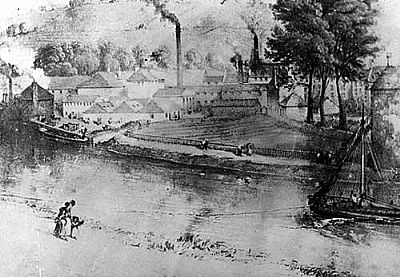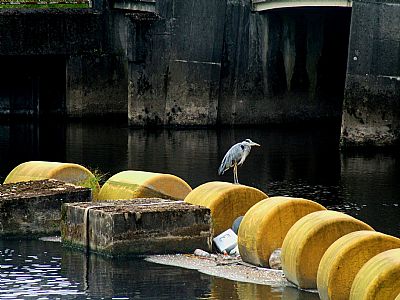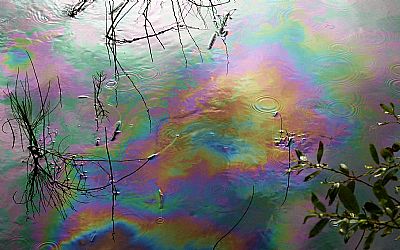POLLUTION
This subject is obviously interconnected with LITTER PICKING & FLY TIPPING and LANDFILL & YET MORE RUBBISH . It is a basic overview comparing the current situation with historical precedent.
Pollution takes several forms:
- Soil
- Air
- Water
- Noise
To which we can add visual amenity. While that can take us into planning requirements and a broader discussion, here we see it more in terms of the detrimental impact on view and the spoiling of urban or natural areas through littering and dumping as discussed under their own sections.
West Dunbartonshire is little different from any other urban area with regards to problems with pollution. It is conspicuously urban in nature although if you look at an aerial view such as on Google maps or on the Local Development Plan (LDP) it is really a very green area edged with urabnisation. We no longer have the heavy industries that we once did. Of those ship building along the Clyde was noteworthy.
Soil pollution
In its heyday the Vale of Leven was industrialised along most of its length from Loch Lomond to the Clyde with factories spewing not just smoke, but the little controlled fumes of a variety of chemicals.
You can find more about the mainly textile related industries here : TURKEY RED & the TEXTILE INDUSTRY, OVERVIEW (See the subtabs too).
Such chemicals and other waste remained in the ground even after the demise of the industries themselves. Some was toxic and required removal and "grouting" to ensure building over by subsequent generations. Most of that has now gone or has been made safe, but two large works sites remain in bad condition - Cordale and Dalquhurn, both loops "promontories" formed by loops in the River Leven and effectively cut off from most of the urban connubation.
You may sometimes find ventilation pipes rising out of carparks. These are to vent the under levels where remants of old tips may still emit gasses such as sulfur or methane.
Air pollution
While the spewing of toxic gasses into the atmosphere is an absolute fraction of what it was in the heyday of West Dunbartonshire's industrial history, it is not quite over. Yet changes are happening. It seems only yesterday since the concept of private vehicles emitting no or at least greatly reduced fumes from fuel combustion seemed a long way off. The next generation may even take that for granted.
Looking back in the history of the Vale of Leven (just one of several industrial areas locally) shows that the whole length of the river had chimneys constantly spewing smoke and gasses. The river is today almost devoid of such nuisances.

This illustration of Bonhill Textile Works is but a snapshot in time and view. It looks almost rural, but you can see 7 industrial chimney stacks emitted smoke and another 5 domestic chimneys that would be towards evening. © West Dunbartonshire Council.
Water pollution
The water quality of the Leven, as with other aspects of the environment, has benefited from the demise of the mainly textile industries. In economic terms the area has suffered, but the environment has benefited.
The textile industries may have benefited from the clean water of the Leven coming out of Loch Lomond, but they did not reciprocate very well. Of interest are the settling tanks within Boathouse Wood / Fishers Wood installed to minimise the impact of runoff before it reached the inlet to the lade that served the Alexandria / Croftengea Works.
See : TURKEY RED : 5 - CROFTENGEA / ALEXANDRIA WORKS
Whatever gets into the Leven reaches the Clyde. Whatever gets into the Clyde reaches the sea. And the quality of the water has far reaching effects.
Boating, whether powered by engines or wind, can have both long-term and immediate effects on the environment. The most obvious example of boats’ impact is the fuel emissions that are released into the air and water. Diesel- and gas-powered boats emit harmful pollutants such as carbon monoxide, nitrogen oxides, sulfur dioxide, and other greenhouse gases into the atmosphere. These pollutants have been linked to respiratory diseases, smog, acid rain, and climate change. Additionally, fuel spills can cause damage to aquatic life and prevent the absorption of sunlight that is essential to underwater ecosystems.
In addition to fuel emissions, boat discharge is another environmental problem caused by boating. Greywater, which includes shower, sink, and laundry water, contains pollutants such as bacteria, soap, and chemicals that can harm aquatic ecosystems. Further, when boats empty their holding tanks, untreated sewage can pollute nearby waterways, leading to the proliferation of harmful bacteria and viruses. [Boating World]
SEPA, the Scottish EnvironmentPr otection Agency, monitors our water. See link below. Our local waters, the Leven and Clyde are shown as "moderate" on their map. While that of the Clyde is perhaps understandable due to the shipping on it, it is shocking to see the Leven at this level, having come from the prestine water sources of the hills via Loch Lomond.
The University of Glasgow also monitors our water quality and you may sometimes see some of their equipment submerged in the Leven within a small sealed plastic container. The issue of water quality, even that not for human consumption, is so important that GU offers post-graduate courses in sustainable water environments. See link below.
Having boats in sensitive natural areas is not always a problem. Birds and fish can co-exist quite happily with boats most of the time.

The float chain at the barrage serves primarily as a safety device to prevent boats passing through the gates, but it also catches a lot of debris including, as seen here, some large floats that have escaped from pontoons upstream and a lot of other muck. Damaged boats even get stuck there, eventually becoming dislodged and drifting downstream.

This photo was taken above the Lomond Bridge (A811) in the first week of September 2025. It shows just some of the fuel leaked from boats upstream from here. While eerily pretty, it can be very problematic for the life within that water. Fortunately most of it will remain on the surface until it evaporates, but we noticed fish attempting to bite at it.
Noise pollution
This goes way beyond the irritation of noisy neighbours, general antisocial noise and screeching traffic; even unattended burglar alarms. Those are usually short lived. It is more to do with continous droning and wining at an industrial level. Building works too have hours set during which noise is acceptable. And such projects will eventually end.
Fortunately West Dunbartonshire Council has the power through its Environmental Health Services to investigate complaints and can use enforcement powers in some cases to try to help.
The Vale of Leven in particular suffers from ongoing npise pollution varying from a deep drone to a high pitched wining. Usually from generators. Sometimes this may continue late into the night. With general sound around us by that time diminished, such noise seems worse.
The proposal to have wind turbines installed in the Kilpatrick Hills accessed from above Bonhill has been very contentious. This has mainly been on their perceived impact on the visual amenity as seen from various points including the Lomond and the Trossachs National Park. In reality, homes within West Dunbartonshire (let alone higher view points) already have view of up to 3 wind farms further afield. A greater concern is the sound they create. While this is generally quite minimal, it can be sufficient to grealy irritate those within reach.
A Norwegian company gives us this : Research reveals that turbines typically produce 35 - 45 dB at a distance of 300 metres, comparable to a quiet residential neighbourhood or the hum of a refrigerator, and far lower than city traffic or vacuum noise. At close proximity, noise can reach 60–80 dB, similar to a lawnmower or busy road, but this diminishes rapidly with increasing distance. [Business Norway].
Wind turbines are much less intrusive on the environment than pylons with cables. The power from windfarms is generally led underground from point of production. But they can become more conspicuous as they move.
For more on the current proposals refer to Vale of Leven Wind Farm
Section 36 Application: Planning & Sustainable Place Statement. This is very detailed. Keep in mind the sustainable energy production in the context of the greater picture of engergy production options. See the link below.
BOATING WORLD : https://www.boatingworld.com/question-answer/are-boats-harmful-to-the-environment/
BUSINESS NORWAY : https://businessnorway.com/articles/what-are-the-health-effects-of-noise-from-wind-turbines
CANAL AND RIVER TRUST : https://canalrivertrust.org.uk/boating/go-boating/a-guide-to-boating/what-you-need-to-know-about-oil-pollution-and-boating
GLASGOW UNIVERSITY : post-graduate courses in sustainable water environments. https://www.gla.ac.uk/postgraduate/taught/sustainablewaterenvironments/
SEPA Water condition map : https://informatics.sepa.org.uk/WaterClassificationHub/
VALE OF LEVEN WINDFARM : https://valeoflevenwindfarm.com/wp-content/uploads/2023/10/Vale-of-Leven-Wind-Farm-Planning-and-Sustainable-Place-Statement.pdf
WEST DUNBARTONSHIRE COUNCIL : Environmental Health Services : https://www.west-dunbarton.gov.uk/public-health-protection/noise-and-vibration/

